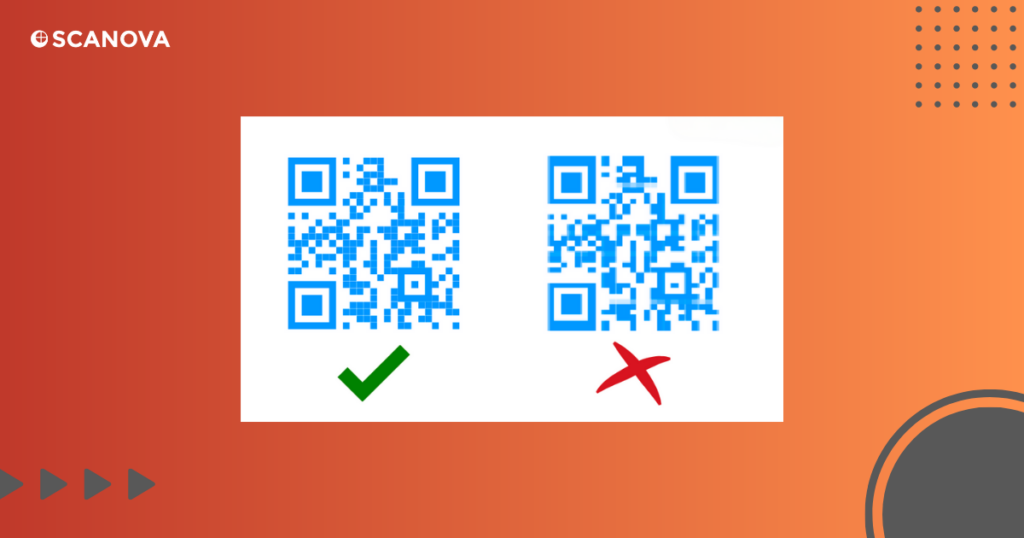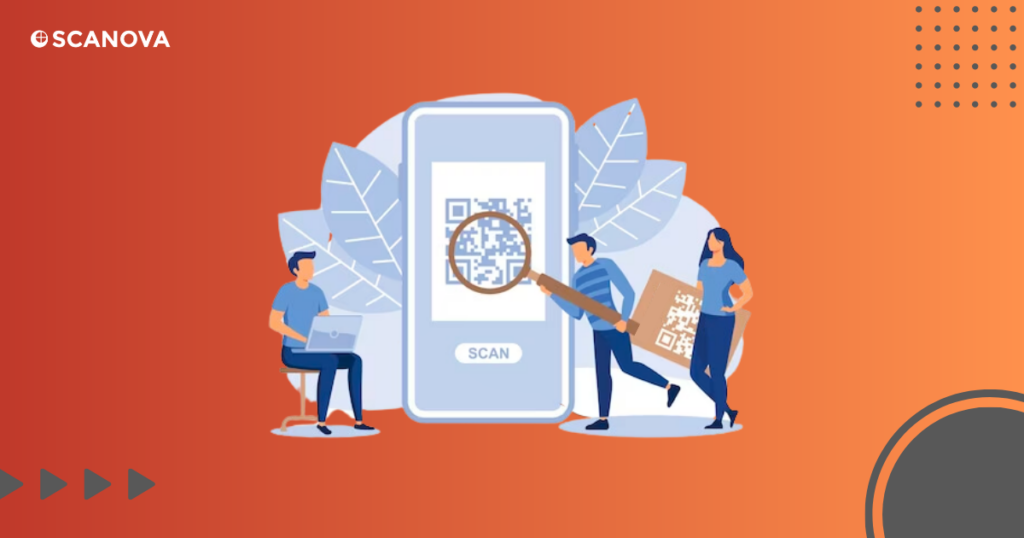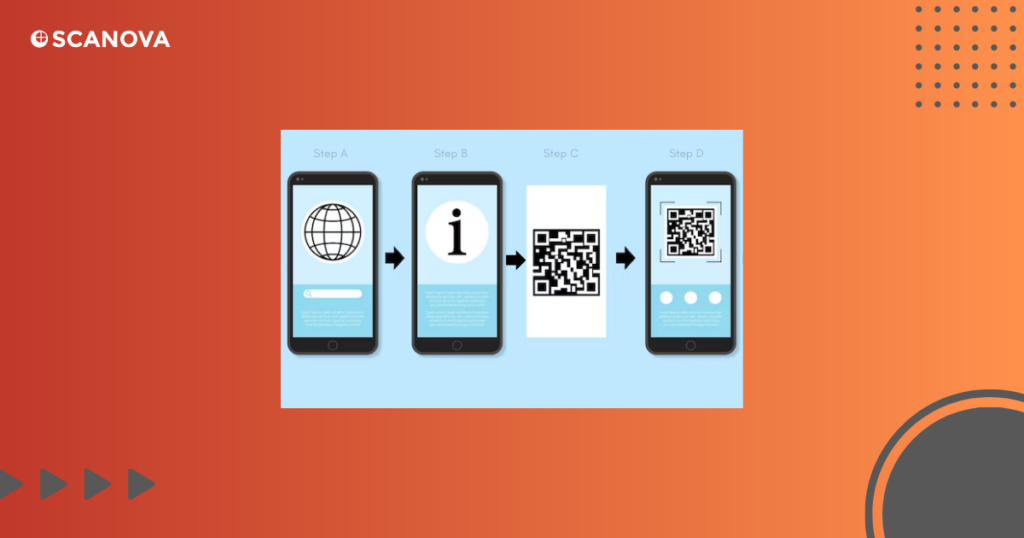QR Codes have become an integral part of our digital lives. However, like any technology, they’re not without their hiccups. QR Code scanning problems can disrupt marketing campaigns, frustrate users, and even lead to lost sales.
This blog post will delve into the most common QR Code scanning issues and provide practical solutions to fix them. By understanding these problems, you can ensure a smooth, hassle-free experience for your users and maximize the effectiveness of your QR Code campaigns.
So, let’s dive in!
A. Common QR Code scanning problems

Let’s look at some of the most common QR Code Scanning problems and what you can do to fix them.
- Color Contrast and Inverted Colors of QR Codes
Color contrast is a critical factor in the scannability of QR Codes. A classic QR Code typically has a light-colored background and a dark-colored foreground. Inverting these colors can lead to scanning issues.
While it might be tempting to prioritize style and design, it’s crucial to remember that you should not compromise on the functionality of the QR Codes. Always use a light color for the background and a dark color for the foreground to ensure optimal scanning.
- Blurred QR Code
A blurry or pixelated QR Code can pose significant challenges for scanners. The quality of your QR Code image is essential for successful scanning.
Always download your QR Code in high resolution, preferably in SVG or PNG format, to avoid blurred output. Though some devices might still be able to scan a low-quality QR Code, it’s better to maintain their quality for better scannability.
- Overcrowded QR Code Data
Overcrowding your QR Code with too much data can lead to scanning issues in static QR Codes. A neat and crisp QR Code scans faster and more efficiently. Therefore, keeping the content simple and avoiding unnecessary information is advisable.
That means, for static QR Codes, more data can reduce the area of the quiet space and its corners, which is important for scanning.
- Mismatched QR Code sizing
The size of the QR Code is another important factor that can impact its scanning success. If the QR Code is too small, it might go unnoticed or fail to scan.
If it’s too large, it might be inconvenient for users. The optimal size for a QR Code is 2 x 2 inches, but this can vary depending on the print material. Here’s a detailed guide to estimate the size of the QR Code.
- Inaccessible QR Code data
Inaccessible QR Code data can result from expired codes or broken links. It’s essential to periodically test your QR Code to ensure it’s working and directing to the correct information. Using a high-quality QR Code generator can help avoid issues with expired codes.
- Incorrect QR Code placement
The placement of your QR Code can significantly impact its visibility and scanning success. Ensure it’s at eye level and large enough to be noticeable and scannable. If the QR Code is placed too low or within 20 inches from the ground, it might not be noticed or scanned.
- QR Code displaying incorrect information
A QR Code that doesn’t display the correct information can lead to user frustration and mistrust. It’s crucial to ensure that the information linked to your QR Code is accurate and up-to-date. This includes the URL, contact details, or any other data embedded in the code.
Always double-check the information before generating the QR Code. If you’re using dynamic QR Codes, update the linked data as needed. Incorrect information not only confuses users but also damages your brand’s reputation.
- Over-customized QR Code Design
While customization can make your QR Code stand out, overdoing it can compromise its scannability. QR Codes need to maintain a certain level of simplicity to be easily scanned by devices.
Over-customization like adding too many colors, intricate designs, or unnecessary elements, can interfere with the scanning process. It’s important to strike a balance between aesthetics and functionality.
Keep your design simple, maintain a high contrast between the foreground and background, and ensure the code’s patterns are clearly visible.
- Expired QR Code
QR Codes, especially dynamic ones, can expire. This happens when the linked URL or data is no longer available or if the QR Code is made to be valid only for a certain period.
Expired QR Codes lead to inaccessible data and broken links, causing inconvenience to users.
To avoid this, always use a high-quality QR Code generator with long-term or indefinite validity. Also, keep a tab of your subscription with your service provider. Regularly check your QR Codes to ensure they’re still working and update them as needed.
- Device unable to scan or recognize the QR Code
Sometimes, the problem lies not with the QR Code but with the device trying to scan it. Certain devices, especially older models, may struggle to scan or recognize QR Codes.
This could be due to outdated software, poor camera quality, or lack of a suitable scanning app. If a device fails to scan or recognize the QR Code, try to:
- Use a different scanning app
- Updating the device’s operating system
- Improving the lighting conditions
It’s also a good practice to provide instructions or troubleshooting tips alongside your QR Codes to assist users.
Also read- QR Code Scanner: How to scan QR Codes with iPhone or Android devices
Generate a QR Code For Your Unique Case
START TODAY!
B. Importance of running a test scan

Running a test scan before printing your QR Codes is a crucial step to pay attention to. It’s not just about ensuring that your QR Codes work, but also making a positive impression and showing accurate data.
Imagine introducing QR Codes to your audience for the first time. You want to captivate their attention and leave a lasting impression. A seamless scanning experience can do just that.
If your QR Codes fail to scan, it can lead to user frustration and a negative impression of your brand.
Unscannable QR Codes can lead to missed opportunities and decreased profitability. You wouldn’t really want that after investing time, effort, and resources.
With a test scan, you can identify potential problems before they cause significant issues. It’ll help you avoid the need for costly reprints and ensuring your campaigns generate the profits they deserve.
C. Steps to create flawless QR Codes with Scanova

Scanova is a powerful QR Code generation tool that lets you easily create, design, and manage QR Codes.
It supports several QR Code types, including URL, text, email, and more. Tehy offer advanced features such as dynamic QR Codes, which you can edit even after printing, and detailed analytics to track your QR Code’s performance.
Its user-friendly interface and robust functionality make it the best choice for businesses and individuals.
Creating flawless QR Codes with Scanova is a straightforward process.
Here’s what you have to do:
- Go to Scanova’s dashboard, select the most appropriate QR Code category that suits your needs. For instance, choose the Website URL QR Code if you want to share a website
- Paste the webpage link you wish to share and click ‘Continue’
- Choose QR Code Type. You are free to choose between a static or dynamic QR Code. Dynamic QR Codes let you edit the content anytime and track scans
- After creating your QR Code, you can customize it. You can change the color and pattern of the data modules and eyes, add a logo, add a background image, and even save your design as a template
- Once you’re satisfied with your design, click ‘Download’. You have to specify the QR Code image’s format and size. Remember to test your QR Code before you download it
That’s it! Isn’t it simple!
D. Best QR Code generators

Here are 5 QR Code generators that you can use to create your own QR Codes:
1. Scanova – Scanova is a comprehensive QR Code generating tool that allows for creating dynamic QR Codes that can be edited anytime, a QR Code designer for personalized designs, and robust tracking and analytics features for performance insights. With its versatile and powerful features, Scanova is an ideal tool for leveraging the power of QR Codes for business or personal needs.
2. Beaconstac – Beaconstac is a top-rated QR Code generator that offers static as well as dynamic QR Codes. It provides many options to customize, including colors, shapes, and logo embedding. Beaconstac also offers analytics for tracking the performance of your QR Codes
3. QR Code Generator Pro – This tool allows you to create dynamic QR Codes that you can edit even after they are printed. QR Code Generator Pro also offers tracking and analytics features, allowing you to monitor your QR Code’s performance
4. Flowcode – Flowcode is a QR Code generator that emphasizes speed and simplicity. It allows you to create highly customizable QR Codes quickly and easily. It also offers analytics to track your QR Code’s scans
5. QR Code Monkey – QR Code Monkey is a free QR Code generator that helps with creating customized QR Codes with logos, colors, and shapes. It supports different kinds of QR Codes and does not require a subscription
Remember, each QR Code generator has its own unique features and capabilities. So choose the one that best suits your needs.
E. Make the most of QR Codes by testing then and fixing the errors
While QR Code scanning problems can be a nuisance, you can solve them. Understanding the common issues and implementing the solutions can ensure that your QR Codes are easy to scan and provide the right information.
Remember, the key to successful QR Code usage lies in regular testing and careful design. So, keep these tips in mind, and you’ll be well on your way to leveraging the full potential of QR Codes for your business.
Generate a QR Code For Your Unique Case
START TODAY!
